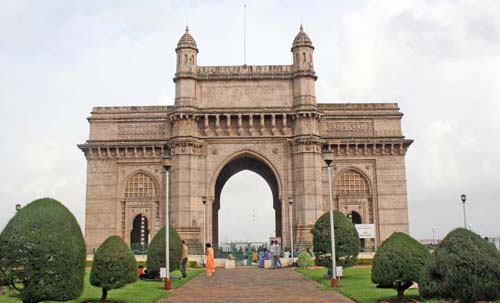Gateway of India Mumbai

Information on Gateway of India (Mumbai, Maharashtra) - History & Architecture
The Gateway of India is one of the most distinctive and renowned historical monuments of India. It is sited in South Mumbai, more specifically around the harbor area of Apollo Bunder, which is surrounded by the Arabian Sea in the Colaba district. It is just 2.5 kilometers away from the Chhatrapati Shivaji Terminal. The Gateway of India symbolizes the dignity of the British during their reign.
Gateway of India Mumbai Architecture
The architectural significance of this massive monument is that it is 26 meters high with a unique architectural style. It was well structured as it combines the artistic excellence of both Hindus and Muslims. The Gateway of India is well structured with the use of yellow basalt rocks along with armored concrete. The material for the construction was transported from not only the local areas but also Gwalior. The style encrypted for the monument is more like an Indo-Saracenic style. With regards to the interior, the dome of the centre is 48 feet in diameter with 83 feet stature. The architecture of the monument is marvelous as it has a passage towards the Arabian Sea from the gateway arch. The Arch was so designed that every corner of the arch can accommodate about six hundred people. The architectural cost for the huge and magnificent structure was borne by the then government of India. Gateway of India is constructed in such a manner that it can experience the beauty of sea. The architecture, design, location and the beauty of the monument makes it a treasured symbol for the people of Mumbai.
Gateway of India Mumbai History
To honor the visit of King George V and Queen Mary, this enormous structured monument was established in the year 1911 in Mumbai. The governor of Mumbai (then Bombay), Sir George Sydenham Clarke laid the first foundation stone. The monument was erected in the year 1920 finally after the approval of the design by George Wittet on 1913. The then Viceroy of India, Rufus Daniel Isaacs, opened the Gateway in the 1924. This historical monument signifies the aspect of colonialisation along with suppression over the Indians by the British. Correspondingly, gateway of India lays the importance of power and majesty that the British had over the Indians, prior to independence. The first and foremost event that took place at Gateway of India was regarding the transient of the 'First Battalion of the Somerset Light Infantry.' This event occurred post independence in the year 1948, when formally the final British troop left India. The price of this historical monument with great significance and story of the British rule over India was about 21 lacs. Moreover, the gateway of India symbolizes the ports of Mumbai. The monument denotes the story of British tyranny and the victory of India as the last troop marched through this historical monument post independence. This signifies our triumph over the British and their power.
Gateway of India Mumbai Tourism Importance
It is a great tourist spot for the people, who loves photography and have interest towards the history of our country. Gateway of India is the prized monument depicting the strong victorious history post independence. The beautiful architecture and historical significance makes it a tourist attraction. The nearby ports, harbors and sea enhance the beauty of the place and the historical architectural monument of Gateway of India. The nearby locations of Elephant caves and the Taj hotel add to its beauty and tourist significance.
- Ahmednagar Monuments
- Akola Monuments
- Amravati Monuments
- Aurangabad Monuments
- Dhule Monuments
- Kolhapur Monuments
- Latur Monuments
- Mumbai Monuments
- Nagpur Monuments
- Nashik Monuments
- Palghar Monuments
- Pune Monuments
- Raigad Monuments
- Ratanagiri Monuments
- Satara Monuments
- Sindhudurg Monuments
- Thane Monuments
- Andaman Nicobar Monuments
- Andhra Pradesh Monuments
- Assam Monuments
- Bihar Monuments
- Chhattisgarh Monuments
- New Delhi Monuments
- Goa Monuments
- Gujarat Monuments
- Haryana Monuments
- Himachal Pradesh Monuments
- Jammu and Kashmir Monuments
- Karnataka Monuments
- Kerala Monuments
- Madhya Pradesh Monuments
- Maharashtra Monuments
- Odisha Monuments
- Punjab Monuments
- Rajasthan Monuments
- Tamil Nadu Monuments
- Telangana Monuments
- Uttar Pradesh Monuments
- West Bengal Monuments